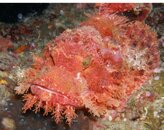...I have the E-620, with Zuiko 14-54 f2.8 lens, Olympus housing an older Sea & Sea YS-90 DX strobe etc...
Can anyone suggest some fairly simple start up settings to begin with, or point me toward a book or an online course that might make my transition a bit less daunting.
That's a fine setup. Without a strobe, I suggest you use Shutter priority with the shutter set fast (say 1/180 or faster) to freeze fish motion; let the camera set aperture. You can use Manual mode too -- I'd still use fast shutter.
With that YS-90DX strobe, it gets more complicated. You can connect to the YS-90 strobe in two ways, either by optical fiber connection, or by a wired cable connection. You can operate the YS-90DX in two modes,
Manual, and
TTL.
CONNECTION: If you use optical connection, light from your camera's strobe
Triggers the YS-90 via its optical sensor; the
Duration of flash is controlled by either the strobe (Manual), or by the camera (TTL). For optical connection, use a fiber cable -- it's reliable and reduces backscatter. You plug the fiber cable into one of the light ports on the camera and on the strobe. Remember to raise the flash on your camera before putting it in the housing and use FILL (forced) flash for TTL or Manual Flash 1/64 for Manual. To enable the optical sensor, set the Slave Switch on the YS-90DX to ON. If you prefer a wired connection, close the flash on the camera, use Manual Flash 1/64, set the YS-90DX Mode Switch to ON and set the Slave Switch to OFF.
Unfortunately you can only use Manual Strobe Operation with a wired connection between Olympus cameras and the YS-90DX (or any non-Olympus strobe); wired TTL does not work (but see below). If you use a wired cable, be very careful your O-rings are sound and properly seated on your strobe cable or you will have to replace a lot of hardware (been there).
STROBE OPERATING MODES: Setting the switches on the YS-90DX controls how it operates with the camera. The Mode Switch controls whether the YS-90DX operates in either
Manual strobe mode (flash duration controlled by strobe), or
TTL strobe mode (flash duration controlled by camera). As mentioned, the Slave Switch enables either the Optical Sensor (ON), or enables the wired cable (OFF).
The Mode Switch has 4 positions: OFF, ON, Pre, or TTL. For Manual Mode, use either the ON or Pre setting, while for TTL, of course use
TTL.
Manual Strobe operation: In Manual strobe mode, the camera triggers the flash but the strobe controls the Duration of the flash from its 12 position switch. To select Manual, use either ON or Pre. I suggest using the ON setting and setting the camera to Manual Flash, 1/64 duration, since the camera flash is only used to trigger the YS-90, not control its flash duration, and this 1/64 setting saves power and reduces reflections inside the housing. In Manual strobe mode, set the Aperture on the camera and and the Duration on the YS-90DX 12 position switch, according to the table in the YS-90DX manual.
You can compute the proper camera aperture as Guide Number / distance to subject, assuming you use full output and ISO 100. For this YS-90DX strobe, Guide Number is 11 (at ISO 100, maximum flash, in water). So for example if the distance to the subject is say 3 feet, the camera aperture should be set to F4 (the guide number divided by the distance, or 11/3 = about 4). In practice, I suspect most people who use Manual strobe use an initial camera setting based on experience (for example ISO 100, 1/180, F4) and vary the aperture and flash duration, observing the result and adjusting. To save flash power and recycle time, you can increase the ISO to 400 without loss of quality. This lets you scale the Guide Number by 4x also, and hence reduce the flash duration by 1/4. With experience, you can get excellent results. But if this sounds too complicated, you can let your camera do the math, by using TTL Strobe Operation.
TTL Strobe operation: For TTL operation, the YS-90 is set to TTL, and the Duration switch is ignored. The YS-90DX can only use optical (not wired, see below) connection in TTL mode with the Olympus camera, so set the Slave Switch to ON. With optical, the YS-90DX mimics the camera flash duration, as seen by the strobe sensor. TTL Strobe operation is not perfect because the camera exposure evaluation is not perfect. It can be fooled and set the wrong exposure for your subject, especially if there are large areas of light or dark in the frame. So feel free to tweak settings if the results are not what you wanted. Try the 3 Spot Metering modes on the E-620, very nice.
IRRECONCILABLE DIFFERENCES: Wired TTL mode won't work with the YS-90DX on Olympus, unless you install a converter in the housing (Heinrichs Weikamp cTTL converter type N5 - $300 at Reef).
http://reefphoto.com/index.php?main_page=product_info&cPath=135_74&products_id=2350
It is listed at working for the PT-E01 and -02, but do verify with Reef that it will work on the PT-E06 before you spend the money. I used this converter on my old Oly for years with this same flash.
WHY NO WIRED TTL? The incompatibility is due to the fact that the YS-90DX strobe uses Nikonos signaling, but for digital cams Olympus invented a new signaling system they call cTTL, which only Oly strobes understand. When the camera is in Manual Flash mode will it use partial Nikonos signaling, so you can trigger the strobe by wire. "What we have here is a failure to communicate."
The YS-90DX manual is here:
http://www.seaandsea.com/PDF_manuals/YS90DX.pdf
Say hello to my friend OLY THE STONEFISH.




